june-top.html
1798 On this day in 1798, General Hunter ordered his troops to split and ensure the British maintain their control of the areas to the north of Wexford. After apparently taking back control of Wexford town in a series of battles over the previous month, the British army realised that the United Irishmen soldiers had moved north to spread their rebellion across the country. General Duff is ordered to lead his regiment to take Bunclody and General Needham to Gorey. The Wexford rebels had actually headed inland towards Kilkenny.
* * *
1844 John Boyle O’Reilly, an Irish-born poet and novelist, was born. He was a member of the Irish Republican Brotherhood, and was transported to Western Australia. He escaped to America, and campaigned for the Irish community and culture through his paper Boston’s The Pilot.
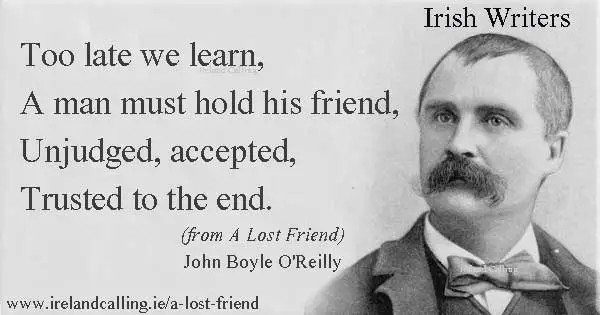 Read the full poem A Lost Friend
Read the full poem A Lost Friend
Read his poem Distance
* * *
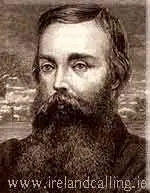 1861 Robert O’Hara Burke died in Australia on this day in 1861. He was the leader of the famous, ill-fated Burke and Wills expedition across Australia in the early 1860s. Their aim was to travel across the whole of Australia south to north, from Melbourne to the Gulf of Carpentaria.
1861 Robert O’Hara Burke died in Australia on this day in 1861. He was the leader of the famous, ill-fated Burke and Wills expedition across Australia in the early 1860s. Their aim was to travel across the whole of Australia south to north, from Melbourne to the Gulf of Carpentaria.
Burke set off from Melbourne with his team of 19 men, 23 horses and 26 camels on 20 August 1860. Within a month of battling through the difficult conditions and searing heat many of the men had given up, including the team medic. Burke was obsessed with reaching the Gulf of Carpentaria first, before another expedition led by explorer Captain Charles Sturt, and win the £2,000 reward.
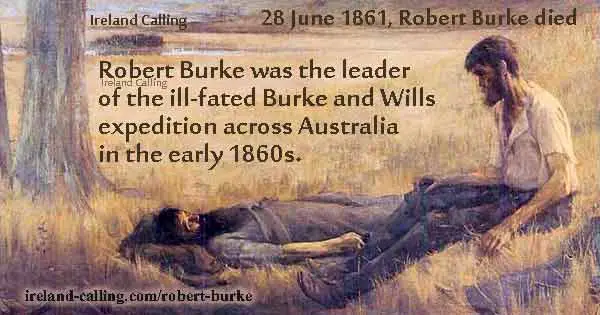 Read more of this ill-fated expedition here
Read more of this ill-fated expedition here
* * *
1920 On this day in 1920, some members of the Connaught Rangers, a troop of British soldiers based in India, refused to serve over the atrocities being carried out by British soldiers in Ireland.
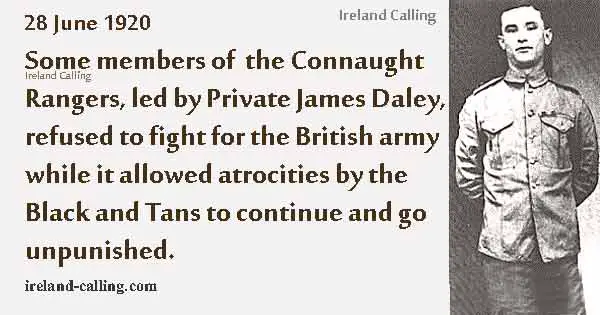
They were led by Private James Daley of County Westmeath, and stated that they would refuse to work until the British troops in Ireland were withdrawn.
Read Private James Daley’s story here
This is from a ballad about James Daley
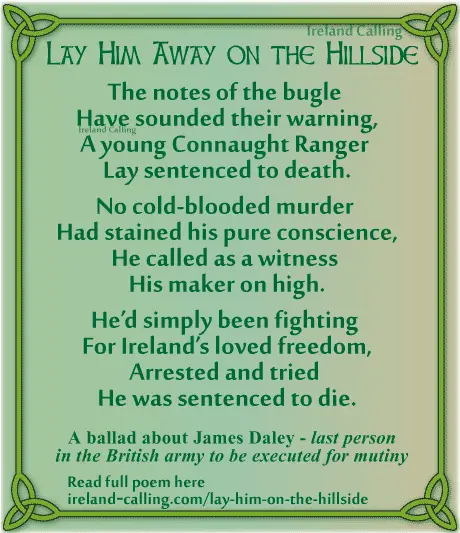 Read the full poem, Lay Him Away on the Hillside.
Read the full poem, Lay Him Away on the Hillside.
* * *
1922 The Irish Civil War is considered to have officially started on this day in 1922. The IRA had been split in two after Michael Collins had signed the Anglo-Irish Treaty a year earlier. Under the terms of the treaty, Ireland had been granted status as a dominion of the British Empire, and was allowed to govern itself as the Irish Free State.
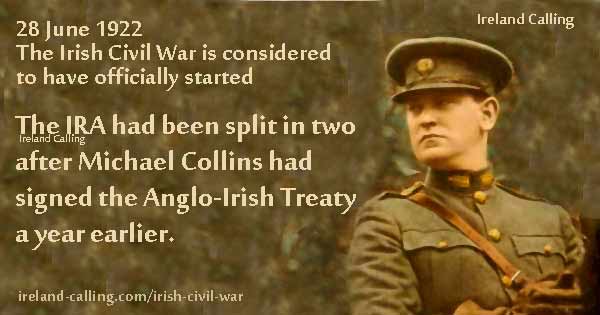
Some members of the IRA though this was an acceptable step forward and total independence could then be pursued over time with political reforms.
However, the other half of the IRA felt the treaty was a betrayal to the proclamation of independence read out by Padraic Pearse during the Easter Rising in 1916. Pearse and several other leaders had been executed for their part in the Rising. The anti-treaty IRA felt that military force was still the way forward in achieving an independent Irish republic.

This resulted in a civil war, with the pro and anti-treaty groups of the IRA now fighting against each other. The anti-treaty IRA were led by Éamon de Valera, and the pro-treaty, now known as the Free Staters, were led by Michael Collins.
Collins was a skilled soldier and had led the IRA through the Irish War of Independence. He had fought in the Easter Rising as a young man, but was spared execution because he was not one of the rebel leaders. However, he had learnt valuable lessons from the fighting in the Easter Rising, and how the Irish rebels were easily cornered by the British because of their stationary position.
As a commander of the IRA in the War of Independence, Collins put his experience to practice and countered the superior weaponry and resources of the British army by ordering his men to carry out surprise guerrilla attacks on the British soldiers. Collins instructed his men to attack in short bursts before retreating rather than entering into a full-on battle in which they would have been overpowered.
De Valera was one of the leaders who had fought in the Easter Rising in 1916. He was spared execution by the British, mainly because he was American by birth. At the time the British were at war with Germany and didn’t want to do anything to compromise the forthcoming military support from America. For that reason, de Valera was spared of the death sentence. In fact, de Valera was more suited to being a politician than a soldier. He had good links in America, and was powerful speaker. He also had the respect of the British government as well as that of his fellow IRA members.
De Valera and Collins had been close associates in the period after the Easter Rising and during the Irish War of Independence. Together, they were a formidable opponent for the British government as they battled for Irish independence. De Valera was articulate and clever in political debates, and Collins was wily and effective in organising his army.
De Valera had sent Collins to England to negotiate the terms of the Treaty with the British government. Collins had said he didn’t feel he was the best man suited to the job, as he lacked the political experience of those he would be negotiating with. However, de Valera had to travel to America to gather support and funding for the ongoing Irish War of Independence so Collins was sent to London.
Collins knew that some members of the IRA would not be happy with the terms of the treaty, but lacked the political skills to negotiate a better deal and felt he had no choice but to sign. In fact, he told his fiancé Kitty Kiernan in one of his letters to her that he had “signed my own death warrant”.

The anti-treaty members of the IRA started fighting against the Free Staters. Rory O’Connor led a troop of anti-treaty fighters to storm the Four Court buildings in Dublin. He hoped that the British army would respond with military force to remove them, and so trigger the Irish Free Staters to step in and defend them, thus re-uniting the fractured IRA back into one unified army with the common enemy of the British government.
However, Collins knew that as leader of the Irish Free State, they had to deal with the matter themselves, rather than turn to the British for support. He was desperate though, not to start a Civil War and took no immediate action. Arthur Griffiths, one of Collins Free State followers tried to persuade him that they had to remove O’Connor’s troops by force, but Collins refused to give the order. An uneasy stand-off had begun.
The British were pressurising Collins to sort the situation and govern the Free State he had been granted, or they would do it for him. However, they were reluctant to take matters into their own hands through fear of re-uniting the two factions of the IRA as O’Connor hoped.
Collins tried to negotiate a surrender from O’Connor but with no success, so he patiently, and nervously waited for matters to develop. They did when, on O’Connor’s orders, the anti-treaty troops kidnapped JJ O’Connell, a soldier in the official government army of the Irish Free State. Collins had no choice to react after a member of his National Army had been taken prisoner.
On 28 June 1922, Collins ordered National Army to take back the Four Courts by force. They bombarded the buildings for two days before O’Connor and his men surrendered. JJ O’Connell survived the battle. The order by Collins to attack the Four Courts to regain control is seen as the point of no return for the two groups of the fractured IRA, and signalled the beginning of a violent Civil War that lasted almost a year.
Collins was assassinated by pro-treaty soldiers less than two months later, proving him right with his prediction to his fiancé Kitty Kiernan that he had “signed his own death warrant”.
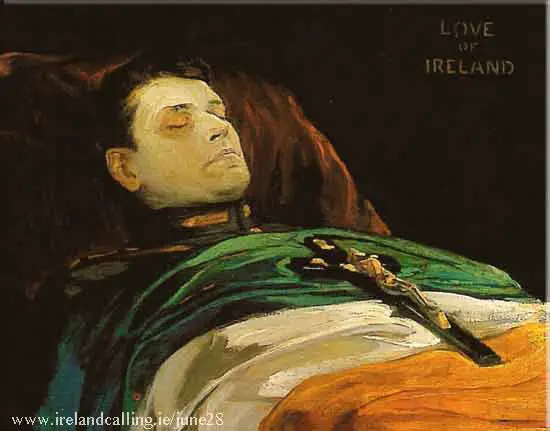
O’Connor was arrested after his surrender at the Four Courts. He was imprisoned and sentenced to death, and was executed by firing squad in December 1922. The man who gave the order for his execution, Kevin O’Higgins, had asked O’Connor to the best man at his wedding less than a year before. The extreme change in the relationship between the two men is a good example of how split the country had become.
O’Connell returned to the Irish Free State National Army and continued to fight against the anti-treaty IRA. He remained working for the Free State Army until his death in 1944.
De Valera went on to become one of the leading figures in Irish history. He became a prominent politician firstly with Sínn Féin, and then founding the Fianna Fáil party. De Valera served as President of the Executive Council (effectively the leader of the country) from 1932 until 1937. He then succeeded himself as leader under the new title of Taoiseach, a position he held on three separate occasions between 1937 and 1959. He later became President of Ireland. De Valera is considered as one of the key men in Ireland’s history.
Anglo–Irish Treaty split the IRA – former comrades turned to fighting against each other.
Execution of Michael Collins – leader got executed in his home county.
Key groups and characters – main figures and leaders of the War.
Essential facts – what you need to know.
* * *
1963 President Kennedy gave a speech to the Irish government at Leinster House, Dublin on this day in 1963. It was the President’s second day of a four-day trip to Ireland.
See an extract from the speech he made:
* * *
1994 On this day in 1994, the Republic of Ireland football team got the result they needed to progress through to the knockout phase of the World Cup in the USA. The team had already produced a shock 1-0 win over Italy which was followed by a narrow 2-1 defeat to Mexico. A draw or win against Norway in their final group game would be good enough to send them into the last-16.
What followed was possibly one of the worst World Cup games of all time as the two Northern European sides struggled in the mid-day heat in Giants Stadium New Jersey. Neither side managed to get a significant effort on goal and the game finished a dour 0-0. Not good for the spectators or for the image of football as an entertaining sport, but great for Ireland who progressed into the knockout phase of their second successive World Cup finals.
june-bottom.html

